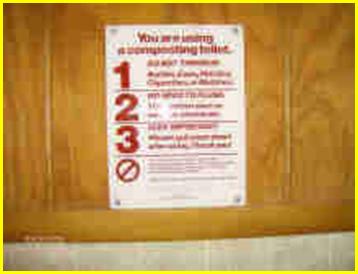I left you with a picture of a composting toilet last month that was taken at one of the lodges in Yellow Creek State Park near Indiana, PA. Except for a sign that advised that the lid be kept down and the lack of a flushing mechanism this unit closely resembled standard bathroom equipment. At first glance this appeared to be a wonderful solution to non-plumbed garages, sheds and camps. Why doesn’t everyone have one of these things?
 The why is in the fact that they are more complicated than they appear to be. First of all you can’t just cobble together a system. To build one from your own components you generally need a permit and these are difficult to obtain. The finished product must be free of pathogens so the system must work properly or it is an environmental hazard, as well as a health hazard.
The why is in the fact that they are more complicated than they appear to be. First of all you can’t just cobble together a system. To build one from your own components you generally need a permit and these are difficult to obtain. The finished product must be free of pathogens so the system must work properly or it is an environmental hazard, as well as a health hazard.
A properly working composting toilet will break down waste into humus that is 10-30% of the original volume. The end product must be inoffensive and relatively pathogen free. The process must minimize odor, human contact with the process and with disease carrying organisms such as flies. In addition to the unit itself a composting toilet, which works just the way your compost heap does utilizing molds, fungi and bacteria, requires other components which make it compatible with household use. A chamber of adequate size for the number of toilets to which it is connected must be installed. A screened exhaust system that usually contains a fan is necessary to remove odors, carbon dioxide, water and other by products of anaerobic decomposition. This is typically vented above the normal “sniff” level but like smoke can be a problem under certain weather conditions. The screening is to prevent flies and other insects, which according to certain sources can enter the system even with precautions.
There are a number of ways of handling the actual decomposition. The simplest is to just provide a ventilation system to provide for the oxygen needs of the bacteria in the chamber. More sophisticated systems churn the decomposing materials or actually provide heat to speed up the process.
 A leach bed is necessary to drain liquids and a means of removing the finished humus must be available. This usually consists of a small door in the chamber. The humus can be buried or disposed of by a service. It cannot be used on vegetable crops.
A leach bed is necessary to drain liquids and a means of removing the finished humus must be available. This usually consists of a small door in the chamber. The humus can be buried or disposed of by a service. It cannot be used on vegetable crops.
Another drawback of the composting toilet is the price. A unit that will work for 6 adults for weekend use only or for three adults for continuous use retails for about $1365. The units without the electrical “helpers” to aid decomposition, such as fans and heaters, are a bit less expensive but the capacity is cut almost in half.
As a last resort at a remote camp these units might be a solution but I don’t think one is going into most garages and sheds anytime soon. They are expensive and if not working properly can cause too many problems.